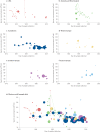Spatiotemporal trends in human semen quality
- PMID: 35978007
- PMCID: PMC9383660
- DOI: 10.1038/s41585-022-00626-w
Spatiotemporal trends in human semen quality
Abstract
Over the past four decades, studies of various designs have reported spatial and temporal trends in human semen quality. Several standardized-methodology studies in homogeneous populations that compare specific cities within a country or a continent provide clear evidence of geographical differences in sperm production, even over short distances within the same country. Human sperm production is widely believed to be declining over time, but evidence from the scientific literature is less clear. Studies based on repeated cross-sectional data from a single centre have shown mixed results. Among the numerous retrospective studies conducted in a single centre, only some included homogeneous groups of men and appropriate methods, and most of them suggest a temporal decrease in human sperm production in the geographical areas considered. Conclusions reporting temporal trends in sperm production that came from existing retrospective multicentre studies based on individual semen data and those using means, medians or estimates of sperm production are questionable, owing to intrinsic limitations in the studies performed. Regardless of study design, studies on the percentage of motile or morphologically normal spermatozoa are still limited by the inherent variability in assessment. Overall, available data do not enable us to conclude that human semen quality is deteriorating worldwide or in the Western world, but that a trend is observed in some specific areas. To understand these trends and contrasts in sperm and semen quality, prospective studies should be encouraged and combined with assessment of the male exposome.
© 2022. Springer Nature Limited.
Conflict of interest statement
The authors declare no competing interests.
Figures


References
-
- Nelson CMK, Bunge RG. Semen analysis: evidence for changing parameters of male fertility potential. Fertil. Steril. 1974;25:503–507. - PubMed
-
- Leto S, Frensilli FJ. Changing parameters of donor semen. Fertil. Steril. 1981;36:766–770. - PubMed
-
- MacLeod J, Wang Y. Male fertility potential in terms of semen quality: a review of the past, a study of the present. Fertil. Steril. 1979;31:103–116. - PubMed
-
- Glass RI, Lyness RN, Mengle DC, Powell KE, Kahn E. Sperm count depression in pesticide applicators exposed to dibromochloropropane. Am. J. Epidemiol. 1979;109:346–351. - PubMed
-
- Milby TH, Whorton D. Epidemiological assessment of occupationally related, chemically induced sperm count suppression. J. Occup. Med. 1980;22:77–82. - PubMed
Publication types
MeSH terms
LinkOut - more resources
Full Text Sources
Miscellaneous

